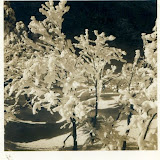Snow scenes
I prefer winter and fall, when you feel the bone structure of the landscape - the loneliness of it, the dead feeling of winter. Something waits beneath it, the whole story doesn't show.
Andrew Wyeth
The Eastman Kodak Company always understood that its success depended upon making photography accessible to amateurs. To do that it needed to convince amateurs that with a little training they could take photographs (just one was enough) to rival those of a professional. With that in mind the company invested a small fortune in manuals and pamphlets intended to show amateurs how easy photography was. The company would have realized too that at Christmas thousands –actually hundreds of thousands – of Americans and Europeans would receive a Box Brownie and the first thing they’d want to do was load a roll of film and rush out into the snow. Magazines like Kodakery went to some pains to calm the excited neophytes with a list of careful instructions in case they ruined the roll of film and decided there and then that cameras were too complicated for them or worse, Kodak was being a touch deceitful with its assurances about the simple pleasures of photography.
‘Expose for the snow’ was the typical warning although some Box Brownies had only two aperture sizes to work off and one speed, plus ‘B’ for the open shutter, so the advice was to ‘expose as quickly as possible’. Actually, photographs in the snow rarely failed. True, the image might not have been what the photographer intended but with a background of white snow, stark, leafless trees and dark figures wrapped against the cold it was always going to look good. The worst that could happen was that the sudden cold played havoc with the film chemicals and gave the print a dull, sombre tint.
Taking photographs in the snow may have sounded technically difficult but Kodakery had a lot more to tell its readers besides what settings to use on their cameras, how to compose the perfect shot and how to get the most out of the new Kodak Velox paper. There were also articles on how to fake snow for quaint, homemade dioramas or a sequence of silhouettes; how, in other words, the humble Box Brownie could achieve the same results as professional animators working for the major film studios.
If there is a thorough exhibition dedicated to the place of snow in photography that needs to be curated it would begin in the 1860s, when technical limitations obliged studios to experiment with snow scenes. The gallery Faux Snow at the American Museum of Photography has some beautiful examples of studio trickery. The exhibition would move on to the French Bisson brothers, Louis and Auguste, who defied conventional wisdom and took their cameras up into the Alps. It would inevitably include Herbert Ponting and Frank Hurley’s work from the Antarctic expeditions in the 1910s but it would have to incorporate a high number of images by unknown amateurs. Ever since photography was made available to amateurs, people have waited for the blizzard to clear and rushed out to document its impact. Snow makes the dirtiest and most decrepit city street look clean again and it encourages us to engage in ancient, pagan rites, like building effigies and staging mock battles. But more than that, people have been irresistibly drawn to the same images; the pine tree with its branches covered in snow and the streets blanketed in white. Those images must be in the exhibition. More than any others they suggest the connection to nature people still feel but can’t articulate.
 |
| WINTER WONDERLAND |




No comments:
Post a Comment
Add comments here